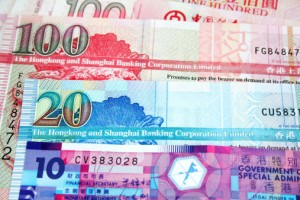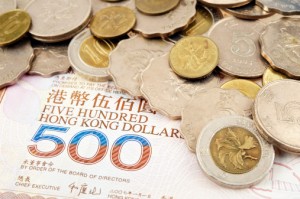Hong Kong Dollar – HKD
Short Facts About HKD – Hong Kong Dollar
![]()
Read our in-depth guide about the Hong Kong Dollar (HKD) below:
- Common names for Hong Kong Dollar
- Countries with Hong Kong Dollar
- How much is the Hong Kong Dollar traded?
- Currency symbol and ISO-code
- Currency crisis with Hong Kong Dollar
- The Hong Kong National Bank
- Online Forex Trading with Hong Kong Dollar
- History of the Hong Kong Dollar
- HKD vs other currencies
- Pictures of Hong Kong Dollar
The Hong Kong dollar is the chief currency of Hong Kong, a former British colony falling under the sovereignty of the People’s Republic of China, although under an autonomous status. The Hong Kong dollar is officially divided into 100 cents, and the largest banknote denomination is the rarely-seen 1,000 note.
Common Names for HKD
The Hong Kong dollar is normally called by the locals as the “hongkie”, and the 10-cent coin is called as the “ho”.
Countries with HKD
Hong Kong is the only official region that uses the Hong Kong dollar as the chief currency, although other industrialised countries such as the United States, Canada, Australia and Singapore, also use the dollar as their currency unit.
Unofficial HKD Countries
Although unofficially, the Hong Kong dollar is also used by residents and traders in Macau, also an autonomous region under the People’s Republic of China. Moreover, the Hong Kong dollar is also used as currency, along with the Chinese yuan, in adjacent Chinese provinces and cities.
How much is the HKD Traded?
The Hong Kong dollar is the eighth most-traded currency in the foreign exchange market, just directly behind the Canadian dollar. Furthermore, the Hong Kong dollar comprises about 2 percent of the active daily exchange on the market.
Currency Symbol and ISO Code
Th ISO code for the Hong Kong dollar is HKD and the currency symbol is $, although the symbols HK$ and HKS are sometimes used by the locals.
Currency Crisis with HKD
The financial crisis that gripped the Asian region in 1997 had the Hong Kong dollar slumping, albeit only by just a very small percentage because of a healthy Hong Kong banking sector. However, it was determined that the slump was mainly caused by speculative attacks, and as the years progressed, the Hong Kong dollar bounced back and remained strong and very stable. Presently, Hong Kong’s banking sector is experiencing big growth because of numerous expansions into the Chinese mainland.
Central Bank for HKD
Formed in April 1993 with the merging of the Office of the Exchange Fund and the Office of the Commissioner of Banking, the Hong Kong Monetary Authority, otherwise known as HKMA, is currently the monetary authority in the Special Administrative Region of Hong Kong.
Headquartered in Hong Kong’s International Finance Centre, the HKMA reports to the Financial Secretary and has the following main functions:
1. Maintain the stability of Hong Kong’s monetary system
2. Ensure that Hong Kong’s monetary objectives, as determined by the Financial Secretary, are achieved
Trade HKD
Based on the latest average currency ranking figures, the Hong Kong dollar’s most active and popular exchange is with the United States dollar (HKD/USD or USD/HKD).
History of the HKD
In the early parts of 1841, Hong Kong was established into a free-trade zone, and the lack of an established local currency led to the local circulation of other foreign currencies such as the Indian rupee, the United States dollar, the Sterling pound, the Chinese yuan and the Mexican real.
It wouldn’t be until 1863 when the British government, through the Royal Mint in London, began minting special silver-based dollar coins that were circulated as major currency in Hong Kong.
In 1935, Hong Kong abandoned the silver standard and started using the Hong Kong dollar as the official currency unit. However, during the Japanese occupation of Hong Kong in World War II, the Japanese yen was the only currency legally accepted for trading. When the war ended in 1945, control of the banking system was fully regained by Hong Kong’s government, and the Hong Kong dollar was restored as the chief currency.
HKD vs other currencies
Against other currencies, the Hong Kong dollar is currently still a very significant currency in the foreign exchange arena and plays an important role in the carry trade. However, some trade analysts are predicting that the Hong Kong dollar’s role may be affected by the Chinese yuan in 2047, the year when Hong Kong will lose its autonomous status and will be under the full control of the government of the People’s Republic of China.
Pictures of HKD notes and coins
The Hong Kong dollar is circulated in banknote denominations of 10, 20, 50, 500 and rarely, 1,000.
Coins are issued by the Hong Kong government and are available in 1, 2, 5 and 10 dollar denominations. Moreover, the coins are also issued in denominations of 10, 20 and 50 cents.
Aside from the Hong Kong government, there are three banks authorized to issue banknotes: the Hong Kong Shanghai Banking Corporation, the Standard Chartered Bank Limited, and the Bank of China Limited.
Hereunder are photos of the banknotes and coins currently used in Hong Kong:







